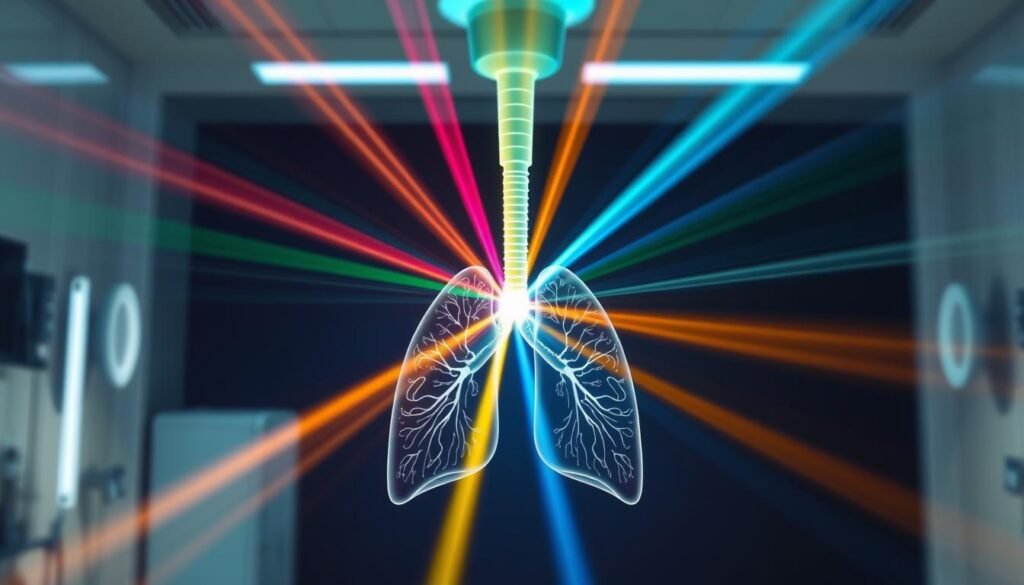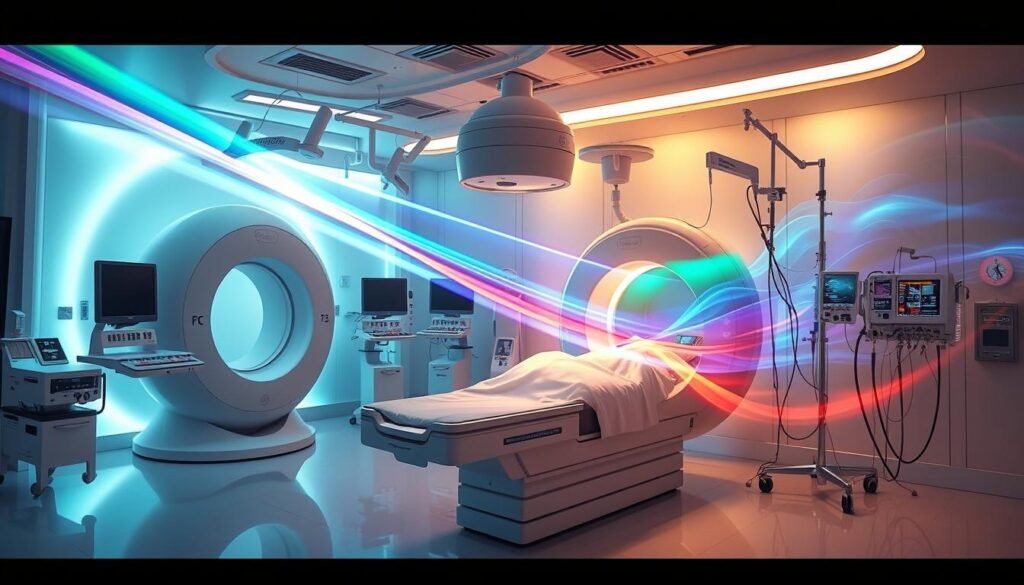About 15% of lung cancer patients turn to radiation therapy as a key part of their care. This shows how important radiation therapy is, especially for those with non-small cell lung cancer who can’t have surgery. Learning how radiation therapy treats lung cancer is vital for patients and their support teams.
We’ll delve into the different types of radiation therapy for lung cancer and the cutting-edge methods used. Radiation therapy aims to destroy or stop the growth of cancer cells. It is often combined with other treatments like chemotherapy. This guide will uncover the vital role of radiation in treating lung cancer.
Key Takeaways
- Radiation therapy is a common treatment for lung cancer and is crucial for many patients.
- External beam radiation therapy (EBRT) is the most frequently used method, often requiring several weeks of treatment.
- The type and duration of radiation therapy vary based on the cancer stage and individual health factors.
- Advanced techniques like Stereotactic Body Radiation Therapy (SBRT) target tumors with precision, often in fewer sessions.
- Side effects of lung cancer radiation therapy can include fatigue, skin irritation, and respiratory issues, which require careful management.
Introduction to Radiation Therapy for Lung Cancer
Radiation therapy is key in treating lung cancer. It uses high-energy X-rays to kill cancer cells. An introduction to radiation therapy shows its importance in the lung cancer treatment overview. It’s used to limit harm to healthy tissues while fighting tumors.
There are two main types of radiation treatment for lung cancer: external beam radiation therapy and brachytherapy. External beam radiation targets specific body areas, aiming doses at cancerous tissue. It’s common for treating non-small cell lung cancer and small cell lung cancer. Conversely, brachytherapy, an internal radiation type, is used for targeted treatments.
Patients have a simulation session before starting radiation therapy. This step maps the radiation’s precise path to the tumor. Knowing the radiation treatment for lung cancer timeline is vital. It sets expectations, as destroying cancer cells to see therapy effects may take days or weeks.
Though effective, radiation therapy may lead to side effects like fatigue and skin reactions. Talking with the healthcare team is crucial for managing these effects. As patients go through radiation therapy, understanding its role in a larger treatment plan helps make informed health decisions.
The Role of Radiation Therapy in Lung Cancer Treatment
Radiation therapy is crucial in treating lung cancer. It is often chosen for patients who can’t have surgery. This is due to either their health issues or the tumor’s location. It can also boost the results of surgery and chemotherapy.
Radiation before surgery can shrink tumors. This makes the surgery easier to do.
External beam radiation therapy is a common choice. It targets cancer cells effectively. High doses of radiation hit the tumor, but spare the healthy tissue around it. Brachytherapy, on the other hand, delivers doses directly to the cancer site. It’s used in special situations.
https://www.youtube.com/watch?v=5F-kwsSoypg
Stereotactic body radiation therapy (SBRT) is important too. It uses high doses over five to eight days. It’s great for cases where surgery isn’t an option. Intensity-modulated radiation therapy (IMRT) adjusts the beam strength for a custom fit to the patient’s needs.
Radiation helps not just to cure but also to ease late-stage symptoms. Its flexibility makes it a key player in lung cancer care. This includes both non-small cell and small-cell lung cancers. For more about lung cancer radiation therapy, check this resource.
How Radiation Therapy is Used to Treat Lung Cancer
Radiation therapy is key in treating lung cancer. It works differently depending on the cancer stage and type. It’s important to know how radiation therapy is used to treat lung cancer. This includes using advanced ways to hit the tumor but not harm the healthy tissue around it.
Overview of Radiation Therapy Techniques
There are many lung cancer radiation techniques. The most used is called external beam radiation therapy (EBRT). This category includes several methods:
- Intensity-Modulated Radiation Therapy (IMRT): Fits radiation beams to the tumor’s shape.
- Stereotactic Body Radiation Therapy (SBRT): Gives strong doses in a few sessions, usually 1 to 5.
- Three-Dimensional Conformal Radiation Therapy (3D-CRT): Molds radiation beams for more accuracy.
- Stereotactic Radiosurgery (SRS): This approach uses a single session to deliver radiation.
- Hypofractionated Radiation Therapy: Could cut down treatment time from weeks to just a few sessions.
Selecting the right technique depends on things like tumor size, where it’s located, and the patient’s health. Radiation therapy is crucial for treating the cancer and easing symptoms in later stages.
When Radiation Therapy is Recommended
When to use radiation therapy depends on the situation:
- As the main treatment for early-stage non-small cell lung cancer (NSCLC).
- Before surgery to make tumors smaller and improve surgery results.
- After surgery, to get rid of any remaining cancer cells.
- For those who can’t have surgery due to other health issues.
- To ease symptoms like pain or trouble breathing in advanced lung cancer.
Talking openly with your healthcare team is vital. Knowing the recommendations for radiation therapy helps patients choose wisely about their care.
| Technique | Advantages | Typical Use |
|---|---|---|
| IMRT | Precise targeting, minimizing damage to healthy tissues | Often used for complicated tumor shapes |
| SBRT | High doses, fewer treatments, shorter duration | Treating small tumors in early stages |
| 3D-CRT | Creates a three-dimensional image of the tumor | Used for conventional treatment plans |
| SRS | Single session, effective for single tumors | Applicable for patients who cannot undergo surgery |
| Hypofractionated Therapy | Shorter treatment period | Used based on specific treatment plans |
Types of Radiation Therapy for Lung Cancer
Radiation therapy plays a vital role in treating lung cancer. There are different methods to suit each patient’s needs. Here are some key techniques used in battling this disease.
External Beam Radiation Therapy
External beam radiation is widely used for lung cancer treatment. It targets the tumor from outside the body with radiation beams. It’s effective for treating different lung cancer types, like non-small cell and small cell lung cancer. The goal is to attack the cancer cells while keeping the nearby healthy tissue safe.
Brachytherapy (Internal Radiation)
Brachytherapy works by placing radioactive materials close to or inside the tumor. It’s especially useful for tumors that obstruct the airways. Since the radiation is focused, it spares the surrounding healthy areas. This method is beneficial for tackling lung cancers that external methods might not effectively reach.
Proton Therapy
Proton therapy is a cutting-edge treatment using protons instead of X-rays. It’s still being researched extensively. This technique allows for pinpoint accuracy, sparing the healthy tissue next to the tumor. Proton therapy marks a leap forward in radiation treatment, potentially lessening side effects seen with traditional methods.

| Type of Radiation | Description | Benefits |
|---|---|---|
| External Beam Radiation | Machine-directed beams targeting the tumor from outside the body. | Effective for NSCLC and SCLC. Minimizes damage to surrounding healthy tissues. |
| Brachytherapy | Radioactive materials placed directly within or near the tumor. | Concentrated radiation dose. Reduces harm to neighboring healthy cells. |
| Proton Therapy | Uses protons to target and destroy cancer cells. | More precise targeting with less impact on healthy tissue. Encouraging results in limiting side effects. |
Radiation Techniques for Lung Tumors
Radiation methods for lung tumors have advanced, giving doctors better ways to fight cancer. They allow for precise targeting. This minimizes harm to healthy tissues nearby. Techniques like SBRT, IMRT, and 3D-CRT are leading in this area. They offer specific benefits depending on the tumor and patient needs.
Stereotactic Body Radiation Therapy (SBRT)
SBRT is a cutting-edge method that targets early-stage lung cancers with high radiation doses in fewer sessions. It uses advanced imaging for accurate tumor location and precise targeting. With usually 3 to 5 sessions, SBRT is convenient for patients. It also protects the nearby healthy tissues well.
Intensity-Modulated Radiation Therapy (IMRT)
IMRT works with beams of radiation that change in intensity. This lets the dose shape closely to the tumor, protecting nearby organs like the heart and lungs. With its adaptable treatment plans, IMRT suits patients with complex tumor shapes really well.
Three-Dimensional Conformal Radiation Therapy (3D-CRT)
3D-CRT uses advanced imaging to make a 3D model of the tumor for precise targeting. This method makes it possible to tailor the radiation fields optimally. It also protects healthy tissues. 3D-CRT is mainly used for different stages of lung cancer and is a key part of radiation therapy.
| Technique | Feature | Advantages |
|---|---|---|
| SBRT | High-dose radiation in fewer sessions | Convenient, precise targeting for early-stage tumors |
| IMRT | Adjustable intensity of multiple beams | Conforms to tumor shape, protects healthy tissues |
| 3D-CRT | Three-dimensional imaging for treatment planning | Optimized dose delivery, excellent precision |
Combining Radiation Therapy with Chemotherapy
Combining radiation with chemotherapy is a big step forward in lung cancer treatment integration. This method is aimed at improving effectiveness, especially for severe lung cancer cases. Studies have shown that combining these treatments can improve patient outcomes.
Chemotherapy treatments usually happen in cycles, every three weeks for about six rounds. This means patients go to the clinic for around five months. Treatment days might be Day 1, Day 8, and Day 15 with a rest week in between. This schedule helps align with radiation treatments to better shrink tumors before surgery.
Chemotherapy can be given in different ways: drips, injections, or tablets. Patients also get medicine to stop sickness and other drugs to prevent bad reactions. Before patients leave, they get the medications they need and contact info for emergency questions.
Studies show that using radiotherapy and chemotherapy together can make treatments work better, though there are hurdles. For example, trials that help us understand these benefits can be small, making it hard to see big improvements in survival rates.

The growing use of treatments that use both methods shows we’re still looking for the best ways to treat patients. Even if big trials haven’t always shown clear benefits, there’s hope for better results in certain groups of patients. More research into how best to combine chemotherapy and radiation could set new standards for treating lung cancer. For more insights, you can check out studies here.
| Treatment Aspect | Chemotherapy | Radiation Therapy |
|---|---|---|
| Delivery Methods | Drip, Injection, Tablets | External Beam, Brachytherapy |
| Treatment Frequency | Every 3 weeks for 6 cycles | Determined by specific protocol |
| Typical Duration | 1 hour to a full day | Varies based on technique |
| Support Medications | Anti-sickness medications | Symptom management as needed |
| Monitoring | Regular check-ins during cycles | Follow-up imaging/assessments |
Palliative Radiation for Lung Cancer
Palliative radiation plays a key role for lung cancer patients. It improves the well-being of those in advanced stages. Instead of seeking a cure, it aims to reduce painful symptoms like pain and breathlessness. This approach helps patients manage the complications of tumor growth.
Purpose of Palliative Radiation
The main goal of palliative radiation is to make patients’ lives better. It’s for patients who can’t have surgery or a lot of chemotherapy. By shrinking tumors, it eases symptoms that make daily life hard. People often feel less pain and can do more after treatment.
When is Palliative Radiation Needed?
Palliative radiation is chosen for different situations in lung cancer care. It’s used when:
- Pain is severe due to cancer spreading to bones.
- Immediate help is needed for spinal cord pressure.
- Bleeding tumors or those causing sores need control.
- Brain cancer spread needs pressure reduction.
- Tumors press or block the airways.
About two-thirds of patients find relief from symptoms with palliative radiation. A team approach is key. Radiation oncologists and nurses customize the treatment. They may use external beam therapy or precise techniques like stereotactic radiotherapy. The goal is to help a lot while causing few side effects.
| Scenarios for Palliative Radiation | Expected Benefits |
|---|---|
| Bone Metastases | Quick pain relief lasting several months |
| Spinal Cord Compression | Prevention of complications, immediate symptom management |
| Brain Metastases | Decrease in tumor size and less pressure |
| Obstructive Symptoms | Removal of airway blockages, easier breathing |
Radiation Dosage for Lung Tumors
Finding the right radiation dose for lung tumors is a careful process. Doctors look at the patient’s health and the tumor’s details. They aim to treat effectively while lowering the risk of harm.
Standard Treatment Protocols
For lung cancer treatment, there are standard radiation doses. For stage III non-small cell lung cancer, before surgery, the dose is 45-54 Gy. The full treatment dose is 60-70 Gy. Higher doses often lead to better results, according to studies.
| Treatment Type | Radiation Dosage | Notes |
|---|---|---|
| Preoperative | 45-54 Gy | Lower dose with no significant long-term mortality difference. |
| Definitive/Nonsurgical | 60-70 Gy | Lower long-term mortality risk observed for 60-70 Gy (hazard ratio = 0.64, p |
| Concurrent Chemoradiotherapy | Approximately 60-66 Gy | Standard approach for locally advanced NSCLC. |
Factors Influencing Radiation Dosage
Many things affect how radiation treatment is planned. A patient’s overall health is important. It determines how well they can handle the radiation. The size and place of the tumor decide how strong the treatment should be. The aim is to control the tumor well and lessen harmful side effects. Thanks to new technology, higher doses can now be given more safely.
Possible Side Effects of Lung Cancer Radiotherapy
Radiation therapy is a key treatment for lung cancer. Knowing the side effects of lung cancer radiotherapy is crucial. This helps patients get ready and tackle any issues during their treatment.
Common Side Effects
Many common radiation therapy effects can happen, such as:
- Fatigue: A common effect that often needs rest and support.
- Skin Reactions: The skin might get irritated, red, or dry.
- Sore Throat: The chest area might swell and become sore, making it hard to swallow.
- Difficulty Swallowing: It may become tough to swallow because of esophagus irritation.
- Shortness of Breath: This usually starts about two weeks into the treatment and may continue.
Managing Side Effects Effectively
Handling side effects properly can improve the treatment process. Some tips include:
- Dietary Adjustments: Eating softer foods like soup and avoiding spicy foods helps. This reduces throat and mouth discomfort.
- Anti-Sickness Medication: Doctors can give medicine to help with nausea.
- Dietitian Consultation: A dietitian can offer food and drink advice for those having trouble eating.
- Inhalers for Breathlessness: Inhalers might be needed for ongoing shortness of breath. Always tell your doctor about any breath changes.
- Hydration and Supplements: Special drinks and supplements can help meet nutritional needs during treatment.
Follow-Up Care After Radiation Therapy
After finishing radiation therapy, it’s key to stay vigilant. Follow-up care after radiation therapy is critical. It helps catch any sign of cancer coming back. Even if tests show no cancer, small hidden cancer cells might still grow.
Different cancers have different risks. So, doctors check each person’s situation. They work to lower the chance of cancer returning.
After therapy, some side effects may appear. They can affect your body and how you feel. Regular checks include physical exams and blood tests. These tests check how well your organs work.
What tests you get depend on your cancer type and stage. If you had radiation, you might need checks on your thyroid each year. This helps spot any changes early.
Keeping a record of your cancer story helps. It includes your diagnosis, treatment, and follow-up plans. This info helps your future doctors understand your health history.
Survivorship care plans are really helpful. They tell you about any other treatments you need. They also list when to have check-ups and important tests. Plus, they include advice on how to manage your health.
It’s important to ask questions about your cancer risk and watch for symptoms. Knowing your treatment and follow-up plan helps you know who to contact. It tells you what tests or help you might need.

Conclusion
This overview shows how important radiation therapy is in treating lung cancer. It’s a key part of care that doctors tailor for each patient. Techniques like external beam radiation and brachytherapy are used based on what’s best for the patient.
Making treatment choices with this knowledge gives patients more control. They feel empowered in their journey to fight cancer. It’s crucial for better results and feeling involved in the process.
Studies have found that the right radiation treatment improves survival rates. Getting therapy without delay is also key for the best outcome. Radiation works with other treatments, such as chemotherapy, for a stronger attack on cancer.
The fight against lung cancer is always advancing, thanks to research. New methods in radiation offer more tailored care and hope for better survival. This growth in knowledge helps patients and their families feel more secure during hard times.